
The Guianan trogon, is a near passerine bird in the trogon and quetzal family Trogonidae. It is found in Brazil, French Guiana, Guyana, Suriname, Trinidad, and Venezuela.

The band-rumped swift is a species of bird in subfamily Apodinae of the swift family Apodidae. It is found from Panama south through Colombia into Ecuador, east from Venezuela into the Guianas and Brazil, and on Trinidad.

The grey-rumped swift or gray-rumped swift is a species of bird in subfamily Apodinae of the swift family Apodidae. It is found in Honduras, Nicaragua, Costa Rica, and Panama; in every mainland South American country except Chile, French Guiana, Suriname, and Uruguay; in Trinidad and Tobago; and on Grenada.
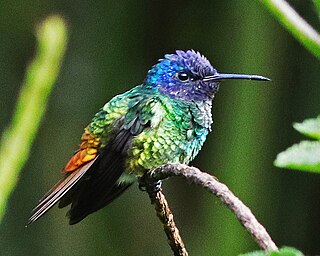
The golden-tailed sapphire is a species of hummingbird in the family Trochilidae. It is found in Bolivia, Brazil, Colombia, Ecuador, Peru, and Venezuela.

The black-bellied thorntail is a species of hummingbird in the "coquettes", tribe Lesbiini of subfamily Lesbiinae. It is found in Bolivia, Brazil, Colombia, Ecuador, Peru, and Venezuela.

The straight-billed hermit is a species of bird in the family Trochilidae, the hummingbirds. It is found in Brazil, Colombia, Ecuador, French Guiana, Guyana, Peru, Suriname, and Venezuela.

Geoffroy's daggerbill, Geoffroy's wedgebill, or eastern wedge-billed hummingbird is a species of hummingbird in the family Trochilidae. It is found in Bolivia, Colombia, Ecuador, Peru, and Venezuela.
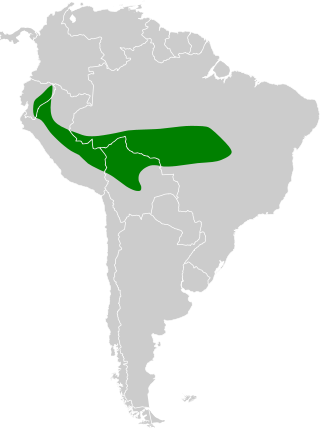
The pale-rumped swift is a species of bird in subfamily Apodinae of the swift family Apodidae. It is found in Bolivia, Brazil, Colombia, Ecuador, and Peru.
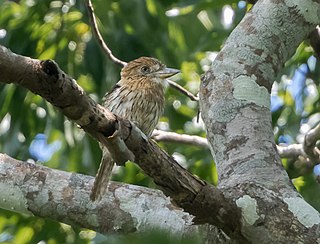
The eastern striolated puffbird is a species of bird in the family Bucconidae, the puffbirds, nunlets, and nunbirds. It is found in Bolivia and Brazil.

The ash-throated crake is a species of bird in the subfamily Rallinae of the rail, crake, and coot family Rallidae. It is found in every mainland South American country except Chile.

The eastern woodhaunter, also known as the Amazonian woodhaunter, is a species of bird in the Furnariinae subfamily of the ovenbird family Furnariidae. It is found in Bolivia, Brazil, Colombia, Ecuador, Peru, and Venezuela.

The black-tailed leaftosser is a species of bird in the subfamily Sclerurinae, the leaftossers and miners, of the ovenbird family Furnariidae. It is found in Bolivia, Brazil, Colombia, Ecuador, French Guiana, Guyana, Peru, Suriname, and Venezuela.

The ringed woodpecker is a species of bird in subfamily Picinae of the woodpecker family Picidae. It is found in every mainland South American country except Argentina, Chile, Paraguay, and Uruguay.
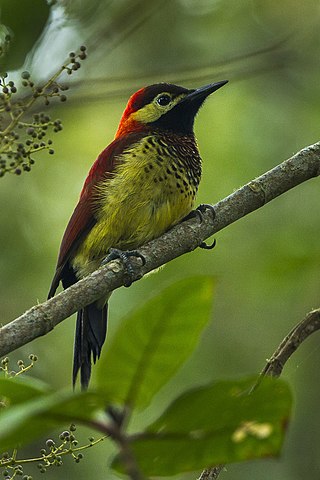
The crimson-mantled woodpecker is a species of bird in subfamily Picinae of the woodpecker family Picidae. It is found in Bolivia, Colombia, Ecuador, Peru, and Venezuela.

The lettered aracari or lettered araçari is a near-passerine bird in the toucan family Ramphastidae. It is found in Bolivia, Brazil, Colombia, Ecuador, and Peru.
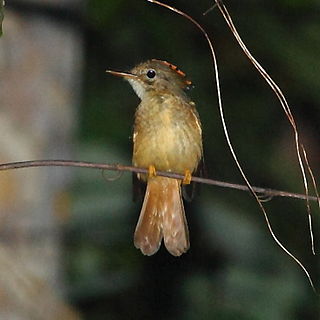
The tropical royal flycatcher is a passerine bird that the International Ornithological Committee (IOC) places in the family Tityridae. It is found in Mexico, south through most of Central America, and in every mainland South American country except Argentina, Chile, Paraguay, and Uruguay.

The Amazonian trogon, is a species of bird in the family Trogonidae, the trogons and quetzals. It is found in Bolivia, Brazil, Colombia, Ecuador, Peru, and Venezuela.

The foothill screech owl is a species of owl in the family Strigidae. It is found in Bolivia, Brazil, Colombia, Ecuador, Guyana, Suriname, and Venezuela.

The white-throated toucanet or greyish-throated toucanet is a near-passerine bird in the toucan family Ramphastidae. It is found in Colombia, Ecuador, and Venezuela.

The butterfly coquette is a species of hummingbird in the "coquettes", tribe Lesbiini of subfamily Lesbiinae. It is found in Bolivia, Brazil, Colombia, Ecuador, Peru, and Venezuela.























